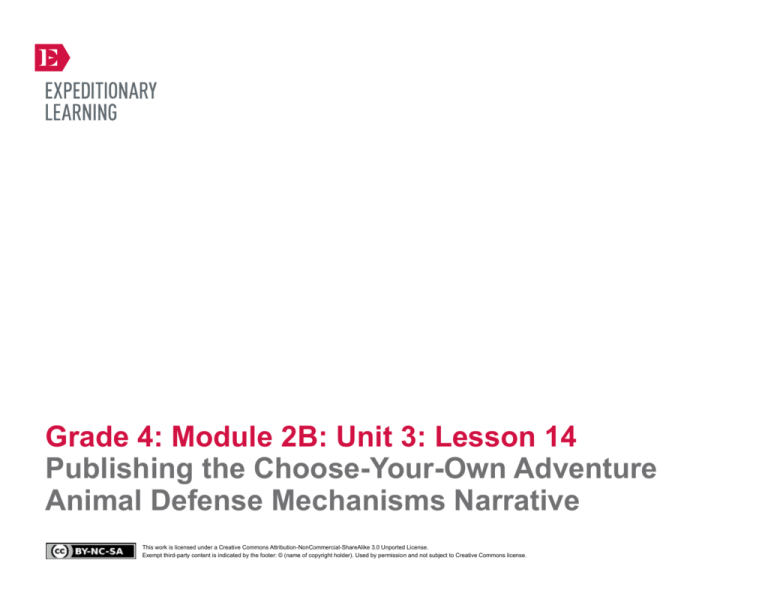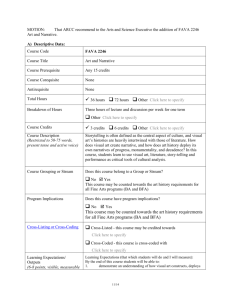
Grade 4: Module 2B: Unit 3: Lesson 14
Publishing the Choose-Your-Own Adventure
Animal Defense Mechanisms Narrative
This work is licensed under a Creative Commons Attribution-NonCommercial-ShareAlike 3.0 Unported License.
Exempt third-party content is indicated by the footer: © (name of copyright holder). Used by permission and not subject to Creative Commons license.
GRADE 4: MODULE 2B: UNIT 3: LESSON 14
Publishing the Choose-Your-Own-Adventure
Animal Defense Mechanisms Narrative
Long-Term Targets Addressed (Based on NYSP12 ELA CCLS)
I can write narrative text about real or imagined experiences or events. (W.4.3)
I can use grammar conventions to send a clear message to a reader or listener. (L.4.1, L.4.2)
I can express ideas using carefully chosen words. (L.4.3)
With support, I can use technology to publish a piece of writing. (W.4.6)
Supporting Learning Targets
Ongoing Assessment
• I can publish my choose-your-own-adventure animal defense mechanisms narrative.
• Choose-your-own-adventure animal defense
mechanisms narratives (final copy)
• I can write a positive comment after reading a classmate’s writing.
Agenda
Teaching Notes
1. Opening
• This lesson is largely dependent upon students having access to a computer, an online dictionary, and a
printer. If students have already had time to word process their second draft on a computer, the timing
of this lesson will work well. If students have not yet started word-processing, consider giving students
additional time to type their final copies.
A. Reviewing Learning Targets (5 minutes)
2. Work Time
A. Modeling: Using Technology to Publish (5 minutes)
B. Independent Work and Conferring (35 minutes)
3. Closing and Assessment
A. Writer’s Gallery (15 minutes)
• If technology is not available in sufficient numbers for your class, consider modifying this lesson to use
standard print dictionaries and focus on students using neat handwriting to create a published copy of
their narratives, using the Performance Task template (version 1 in Lesson 1).
• Depending on pace, students may need additional time for publishing. To provide this time, you may
wish to move the Writer’s Gallery in the closing of this lesson to another day.
• In advance:
– Prepare the Steps for Publishing My Narrative chart (see supporting materials).
– To celebrate students’ learning during the Writer’s Gallery in the closing of this lesson, consider
creating a festive mood in the classroom: soft music, maybe some sparkling cider, perhaps a banner
congratulating the writers on their publication. You may consider inviting parents or other adults
from the school to share in the celebration of students’ learning.
Copyright © 2013 by Expeditionary Learning, New York, NY. All Rights Reserved.
NYS Common Core ELA Curriculum • G4:M2B:U3:L14 • June 2014 •
1
GRADE 4: MODULE 2B: UNIT 3: LESSON 14
Publishing the Choose-Your-Own-Adventure
Animal Defense Mechanisms Narrative
Lesson Vocabulary
Materials
publish, positive, comment
• The technology to allow students access to a computer screen, word-processing software, the internet, and printer
• LCD projector
• Computers for students
• Printer and paper
• Choose-Your-Own-Adventure Narrative Rubric (from Lesson 3)
• Steps for Publishing My Narrative anchor chart (new; teacher-created; see supporting materials)
Meeting Students’ Needs
Opening
A. Reviewing Learning Targets (5 minutes)
• Introduce the first learning target only: “I can publish my choose-your-own-adventure animal defense mechanisms
narrative.”
• Circle the word publish and ask students to turn to a partner and share what they think this word means. Call on a few
students to share their partners’ thinking. Ask students:
* “What reference resources can you use to check your thinking?”
• Some answers might be: a dictionary, Google, peers, or the teacher. Tell them that today they will be using a computer both
as a reference source and to publish their narratives.
Copyright © 2013 by Expeditionary Learning, New York, NY. All Rights Reserved.
NYS Common Core ELA Curriculum • G4:M2B:U3:L14 • June 2014 •
2
GRADE 4: MODULE 2B: UNIT 3: LESSON 14
Publishing the Choose-Your-Own-Adventure
Animal Defense Mechanisms Narrative
Work Time
Meeting Students’ Needs
A. Modeling: Using Technology to Publish (5 minutes)
• Ask students to sit where they can see the projection of your computer. Let students know that today is the day they prepare
their work to make it public—in other words, “publish” it.
• If using a conventional printed
dictionary, you might want to
review searching for a word using
alphabetical order.
• Project a Web site such as www.dictionary.com or www.wordcentral.com. Tell students that you are going to use this online
resource to check their thinking about the word publish. Type the word “publish” into one of the online dictionaries and read
the definitions. Have students turn to a partner and explain what it means to publish their writing. Have a few pairs share
their thinking.
• Please bear in mind that Youtube, social media video sites, and other website links may incorporate inappropriate content
via comment banks and ads. While some lessons include these links as the most efficient means to view content in
preparation for the lesson, be sure to preview links, and/or use a filter service, such as www.safeshare.tv, for actually viewing
these links in the classroom.
• Set purpose: Remind students that they will be sharing their published narratives with an audience—their classmates. Tell
them that in order to publish their choose-your-own-adventure narratives, they need to be sure everything is complete and
correct. Today they will have time to polish their writing, including both Choice #1 and Choice #2 from the End of Unit 3
Assessment in Lesson 13.
• Demonstrate how to use the online dictionary to identify misspellings. Show students how to scroll down and check for
possible correct spellings by checking the definitions.
• If possible, expand the audience to
include others who are not a part of
the class (e.g., teachers, principal,
parents, other classes). This can be
motivating and exciting for
students. See recommendations for
the Writer’s Gallery Teaching Notes.
• Some students who have difficulty
spelling might have a hard time
finding the correct spellings for
severely misspelled words. Keep
these students in mind for
conferencing during this time.
• Ask students to get out their Choose-Your-Own-Adventure Narrative Rubrics.
• Post the Steps for Publishing My Narrative chart:
– Read your draft and correct conventions based on editing notes.
– Check your narratives one last time using the Choose-Your-Own-Adventure Narrative Rubric.
– Rewrite your draft to include the corrections and revisions.
B. Independent Work and Conferring (35 minutes)
• Have students move to a computer to begin work following the Steps for Publishing My Narrative chart.
• Confer with students as needed and when they decide they are finished.
• When students indicate they are finished, ask them to add a footer to their paper with their full name. This avoids confusion
when students print their papers.
Copyright © 2013 by Expeditionary Learning, New York, NY. All Rights Reserved.
• Depending on pace, students might
need additional time for publishing.
If this is the case, consider
extending this portion of the agenda
and move the Writer’s Gallery in
closing to another day.
NYS Common Core ELA Curriculum • G4:M2B:U3:L14 • June 2014 •
3
GRADE 4: MODULE 2B: UNIT 3: LESSON 14
Publishing the Choose-Your-Own-Adventure
Animal Defense Mechanisms Narrative
• Help them to assemble their narratives and to include their cover and sketches from the Performance Task Template
(version 1, from Lesson 1) to prepare for the Writer’s Gallery.
Copyright © 2013 by Expeditionary Learning, New York, NY. All Rights Reserved.
NYS Common Core ELA Curriculum • G4:M2B:U3:L14 • June 2014 •
4
GRADE 4: MODULE 2B: UNIT 3: LESSON 14
Publishing the Choose-Your-Own-Adventure
Animal Defense Mechanisms Narrative
Closing and Assessment
Meeting Students’ Needs
A. Writer’s Gallery (15 minutes)
• Introduce the second learning target for this lesson, “I can write a positive comment after reading a classmate’s writing.”
• Another variation on this type of
sharing is to have students form
small groups and take turns reading
their work out loud. The group can
record one comment after each
reading and feedback can be given
once all students have shared. Then
students can read the comments
written for them by their group
members. This variation gives
students an opportunity to practice
reading their own writing aloud but
is not as efficient.
• Tell students that today they will celebrate their work as writers of choose-your-own-adventure narratives with a Writer’s
Gallery. Praise all the reading, research, and writing they have done to learn about animal defense mechanisms and publish
their narratives. Congratulate them on their perseverance and creativity.
• Explain to students that during the Writer’s Gallery, they will have an opportunity to read another classmate’s narrative and
leave a positive comment about that work. Share the first learning target: “I can write a positive comment after reading a
classmate’s writing.” Remind students that they have been practicing giving kind and helpful feedback to their writing
partners, but today they will focus only on what they think the writer did well in the work they read.
• Explain the meaning of the phrase positive comment and remind them that comments that are specific and kind will be
more meaningful than comments such as “This is good.” Tell students that once they have read another’s work, they will
write the positive comment on a sticky note and leave it on their desk.
• Assign each student another student’s work to read. Post the following directions for students to follow for the Writer’s
Gallery:
1. Clear your desk and put your narrative on top.
2. Go to your assigned author’s desk.
3. Read his or her narrative.
4. Leave a positive comment.
5. Go to an open desk and repeat Steps 3–5.
• Explain that they will not get to read all the stories in the class but should have time to read at least one, if not two or three.
• Let them know that the Writer’s Gallery is silent so everyone can read without distraction.
• Once time is up, ask students to go back to their desks and read their positive comment(s).
• Congratulate them on a job well done.
Homework
Meeting Students’ Needs
• None.
Copyright © 2013 by Expeditionary Learning, New York, NY. All Rights Reserved.
NYS Common Core ELA Curriculum • G4:M2B:U3:L14 • June 2014 •
5
Grade 4: Module 2B: Unit 3: Lesson 14
Supporting Materials
This work is licensed under a Creative Commons Attribution-NonCommercial-ShareAlike 3.0 Unported License.
Exempt third-party content is indicated by the footer: © (name of copyright holder). Used by permission and not subject to Creative Commons license.
GRADE 4: MODULE 2B: UNIT 3: LESSON 14
Steps for Publishing My Narrative Chart
Teacher Directions: Prepare a chart paper with the following directions for students.
Steps for Publishing My Narrative:
1. Read your draft and correct conventions based on editing notes.
2. Check your narratives one last time using the Choose-Your-Own-Adventure Narrative
Rubric.
3. Rewrite your draft to include the corrections and revisions.
Copyright © 2013 by Expeditionary Learning, New York, NY. All Rights Reserved.
NYS Common Core ELA Curriculum • G4:M2B:U3:L14 • June 2014•
7









